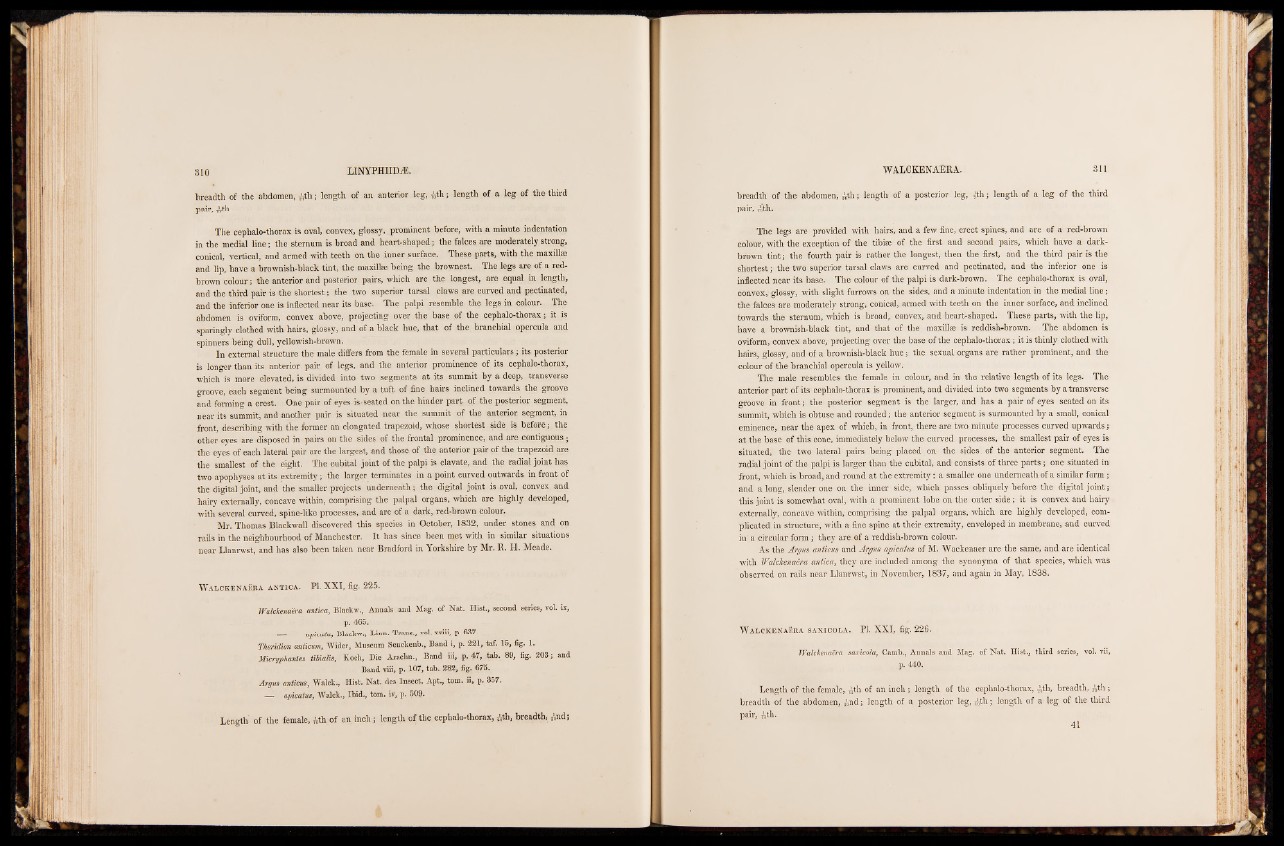
The cephalo-thorax is oval, convex, glossy, prominent before, with a minute indentation
in the medial line; the sternum is broad and heart-shaped; the falces are moderately strong,
conical, vertical, and armed with teeth on the inner surface. These parts, with the maxillae
and lip, have a brownish-black tint, the maxillae being the brownest. The legs are of a red-
brown colour; the anterior and posterior pairs, which are the longest, are equal in length,
and the third pair is the shortest; the two superior tarsal claws are curved and pectinated,
and the inferior one is inflected near its base. The palpi resemble the legs in colour. The
abdomen is oviform, convex above, projecting over the base of the cephalo-thorax; it ij
sparingly clothed with hairs, glossy, and of a black hue, that of the branchial opercula and
spinners being dull, yellowish-brown.
In external structure the male differs from the female in several particulars; its posterior
is longer than its anterior pair of legs, and the anterior prominence of itp cephalo-thorax,
which is more elevated, is divided into two segments at its summit by a deep, transverse
groove, each segment being surmounted by a tuft of fine hairs inclined towards the groove
and forming a crest. One pair of eyes is-seated on the hinder part of the posterior segment,
near its summit, and another pair is situated near the summit of the anterior segment, in
front, describing with the former an elongated trapezoid, whose shortest side is before; the
other eyes are disposed in pairs on the sides of the frontal prominence, and are contiguous ;
the eyes of each lateral pair are the largest, and those of the anterior pair of the trapezoid ape
the smallest of the eight. The eubital joint of the palpi is clavate, and the radial joint has
two apophyses at its extremity; the larger terminates in a point curved outwards in front of
the digital joint, and the smaller projects underneath*,,the digital joint is oval, convex,, and
hairy externally, concave within, comprising the palpal organs, which are highly developed,
with several curved, spine-like processes, and are of a dark, red-brown Colour.
Mr. Thomas Blackwall discovered this species in October, 1832, under stones, and on
rails in the neighbourhood of Manchester. It has since been met with in similar situations
near Llanrwst, and has also been taken near Bradford in Yorkshire by Mr. R. H. Meade.
Walckenaera antjca. PI. XXI, fig. 225.
Walckenaera antica, Blackw., Annals and Mag. of Nat. Hist., second series, vol. ix,
p, 465.
— apicata, Blackw., Linn. Trans., vol. xviii, p. 637.
Theridion anticum, Wider, Museum Senckenb., Band i, p. 221, taf. 15, fig. 1.
Micryphanles tibialis, Koch, Die Arachn., Band iii, p. 47, tab. 89, fig. 203; and
Band viii, p. 107, tab. 282, fig. 675.
Argus anticus, Walck., Hist. Nat. des Insect. Apt., tom. ii, p. 357.
— apicatus, Walck., Ibid., tom. iv, p. 509.
Length' of the female, Ath of an inch; length of the cephalo-thorax, ^th, breadth, And;
breadth of the abdomen, A ft; length of a posterior leg, 4th ; length of a leg of the third
pair, ^th.
The legs are provided with hairs, and a few fine, erect spines, and are of a red-brown
colour, with the exception of the tibiae of the first and second pairs, which have a dark-
brown tint; the fourth pair is rather the longest, then the first, and the third pair is the
shortest; the two superior tarsal claws are curved and pectinated, and the inferior one is
inflected near its base. The colour of the palpi is dark-brown. The cephalo-thorax is oval,
convex, glossy, with slight furrows on the sides, and a minute indentation in the medial line;
the falces are moderately strong, conical, armed with teeth on the inner surface, and inclined
towards the sternum, which is broad, convex, and heart-shaped. These parts, with the lip,
have a brownish-black tint, and that of the maxillte is reddish-brown. The abdomen is
oviform, convex above, projecting over the base of the cephalo-thorax; it is thinly clothed with
hairs, glossy, and of a brownish-black hue; the sexual organs are rather prominent, and the
colour of thé branchial opercula is yellow.
The male resembles the female in colour, and in the relative length of its legs. The
anterior part of its cephalo-thorax is prominent, and divided into two segments by a transverse
groove in front; the posterior segment is the larger, and has a pair of eyes seated on its
summit, which is obtuse and rounded; the anterior segment is surmounted by a small, conical
eminence, near thé apex of which, in front, there are two minute processes curved upwards;
at the base of this cone, immediately below the curved processes, the smallest pair of eyes is
situated, the two lateral pairs being placed on the sides of the anterior segment. The
radial joint of the palpi is larger than the cubital, and consists of three parts; one situated in
front, which is broad, and round at the extremity; a smaller one underneath of a similar form;
and a long, slender one on the inner side, which passes' obliquely before the digital joint;
this joint is somewhat oval, with a prominent lobe on the outer side; it is convex and hairy
externally, concave within, comprising the palpal organs, which are highly developed, complicated
in structure, with a fine spine at their extremity, enveloped in membrane, and curved
in a circular form; they are of a reddish-brown colour.
As the Argus anticus and Argus apicatus of M. Wackenaer are the same, and are identical
■with Walckenaera antica, they are included among the synonyma of that species, which was
observed on rails near Llanrwst, in November, 1837, and again in May, 1838.
Walckenaëra saxicola. PI. XXI, fig. 226.
Walckenaera saxicola, Camb., Annals and Mag. of Nat. Hist., third series, vol. vii,
p. 440.
41